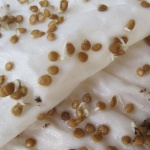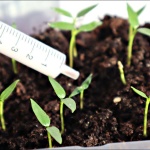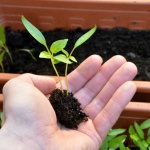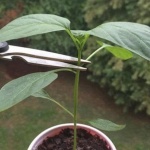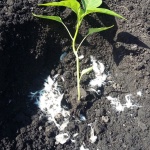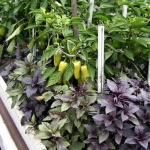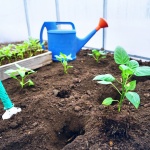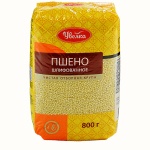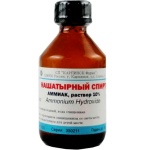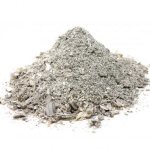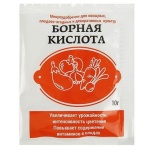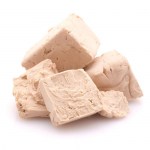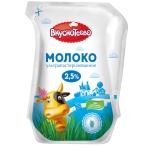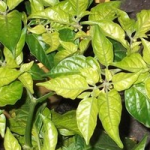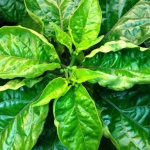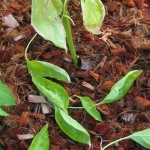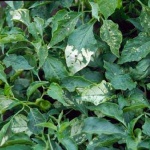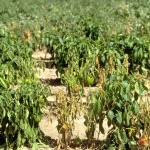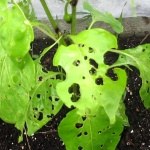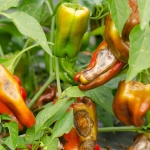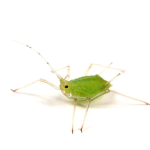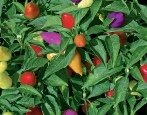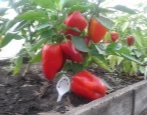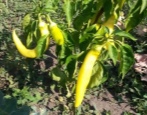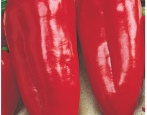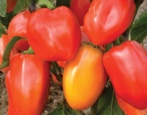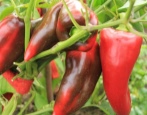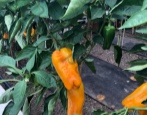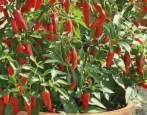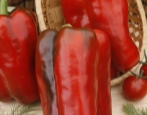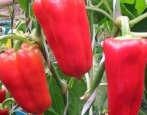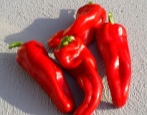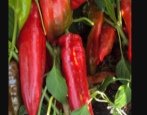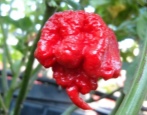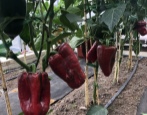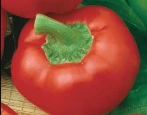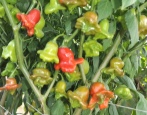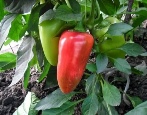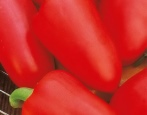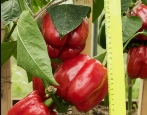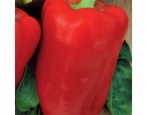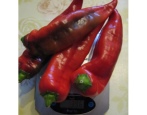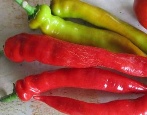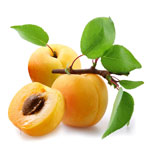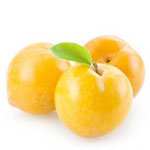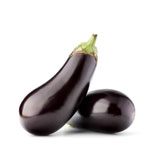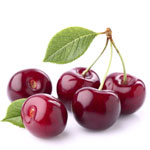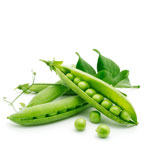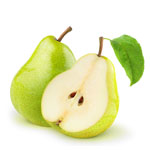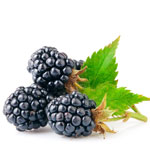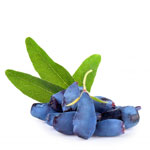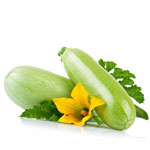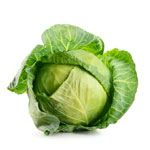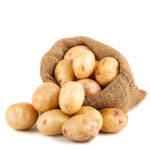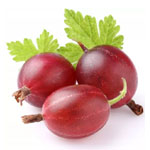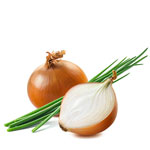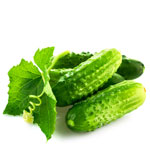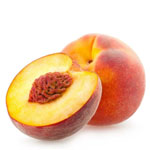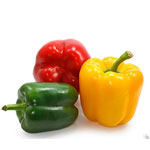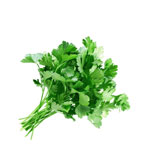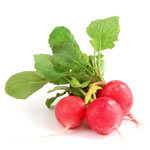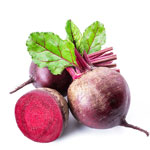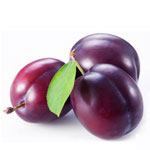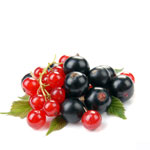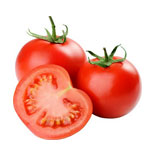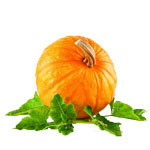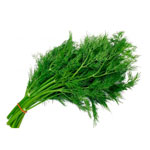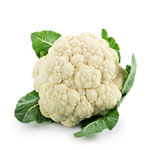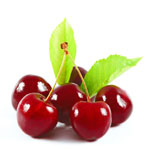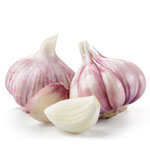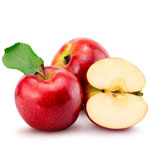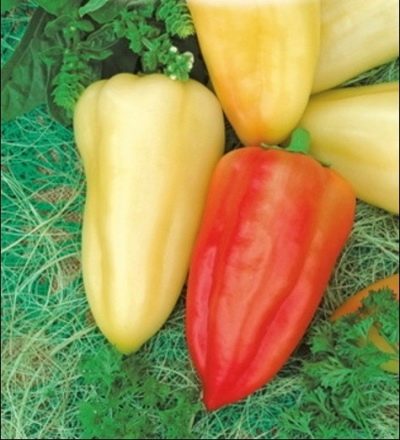
- Year of approval: 1992
- Bush height, cm: 40-70
- Fruit shape: conical
- Fruit weight, g: 77-90
- Fruit color: light cream in technical ripeness, red in biological ripeness
- Ripening terms: mid-early
- Ripening month: July 20-August 30
- Yield: high
- Average yield: 1.5-1.8 kg / sq.m
- Appointment: universal
White-fruited sweet pepper varieties are still considered exotic, although selection in this direction has been carried out for a long time. Pepper Belozerka was included in the State Register in 1992.
Description of the variety
Belozerka is a variety with a twist. It is a medium-sized pepper with abundant fruits of an interesting color. The variety is recommended for commercial production. This means that with good agricultural technology, the variety will show excellent yields, the fruits will be leveled and beautiful.
Characteristics of the appearance of plants and fruits
The bush is 40-70 cm high, sometimes up to 90 cm, standard, with branches tightly adhering to the stem, not spreading. Leaves are light green, large. The stems are powerful, thick.
Fruits are large cones, weighing 77-90 grams. There is a slight ribbing. The tip is sharp. The skin is smooth, at the stage of technical ripeness it is creamy. Wall thickness - 6-8 mm. The number of seed nests is 2-3. Seeds on short legs, it is convenient to peel peppers. By the time of biological ripeness, the fruits turn red. Keeping quality is good. Fruits, taken at the stage of technical ripeness, are stored in the refrigerator for more than 2 weeks.
Purpose and taste
The taste of the fruit is excellent, the walls are thick, sweet and juicy, with a magnificent spicy aroma of bell pepper. The fruits are universal: they are used in fresh dishes and in preservation. The variety is suitable for any table purpose - from stuffed peppers to salads. Suitable for all types of seaming for the winter. Perfectly retains its qualities when frozen.
Ripening terms
The variety is medium early. The fruits reach technical ripeness on the 114th day. In the recommended regions, the fruits are harvested from July 20 to August 30. In other regions - 2-3 weeks later.
Yield
The yield of marketable fruits is on average 1.5-1.8 kg per 1 sq. m. Fruiting is abundant, long-term, the fruits are removed until frost.
Growing regions
The variety is recommended for cultivation in the North Caucasian and Volgo-Vyatka regions. But nothing prevents you from growing medium early varieties in seedlings in other regions. In Siberia and the Urals, high agricultural technology will be required. Peppers are traditionally a demanding crop, but there are varieties that are less and more hardy. According to reviews, Belozerka grows well in the South Urals in the open field, does not get sick.
Landing scheme
The distance between plants is 40-50 cm, in row spacings - 60 cm.
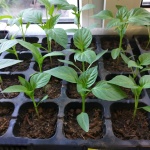
To get a large and tasty harvest of pepper, you need to take care of the seedlings in advance. When growing pepper seedlings, you need to correctly determine the sowing time, pre-sowing seed treatment, prepare the necessary container and soil.
Growing and care
Recommended for outdoor cultivation.
Seeds for seedlings are sown in mid-March. For stronger seedlings, it is good to use backlighting. Seedlings appear in 2 weeks.
In open ground, plants are planted in the recommended regions from 10 to 20 May. In colder regions, they wait until early June. Peppers need a stable warm temperature without the threat of recurrent frost. The soil should warm up to + 15 ° С.
For landing, choose a sunny open place. Shading should be avoided as it greatly affects the taste and quantity of the fruit.And also undesirable places where plants can burn out in the scorching sun, and the soil dries up greatly.
The best soil for planting is light, breathable loam or sandy loam. It is important that the soil is loose, dries quickly, with good air access to the roots. And also the soil should be nutritious, with an acidity of 6.4 pH. On too acidic soils, peppers feel depressed, and on slightly acidic soils, yield decreases. It is important to avoid an excess of nitrogenous fertilizers - in this case, you can not wait for the fruits, although the bushes will be powerful and beautiful.
The variety does not grow well in greenhouses, it may not have enough fresh air. However, in spacious greenhouses in cold regions, it is grown without problems, the fruits are harvested early, you can get them already in June (if you sow seeds in February).
A garter may be required for grown-up plants, especially when the fruit is being poured. The variety has powerful stems, but the foliage is active and large, the fruits are also not small.
Need regular watering as needed. In hot periods, peppers are watered twice a day, in the morning and in the evening, on cool days, watering is reduced to 1 time per week, in mid-autumn watering can be completely stopped. The taste and quantity of fruits depends on sensitive watering. It is important not to overdo it: peppers do not like standing water, and dampness attracts slugs. After watering, it is advisable to thoroughly loosen the soil, if it is not possible to follow the plants, you can mulch with dry humus.
If slugs were seen in the garden, all plant residues, weeds and grass are removed from the site, and grooves are made around the beds with peppers, into which wood ash is poured. It will also act as a source of potassium, which will enter the soil with irrigation.
Stepsons grade according to needs and capabilities. If you need a small and reliable amount of peppers, stepchildren are removed. If it is possible to provide the plant with warmth, watering and feeding until the end of autumn, it is not necessary to remove excess shoots.
Peppers love top dressing, Belozerka is no exception. After planting in a permanent place, the peppers are traditionally fed after 2 weeks. You can use organic matter, for example, bird droppings diluted in 20 parts of water, or mineral fertilizer (2 tsp superphosphate and 2 tsp urea per bucket).
In the future, the pepper is fed 2-4 times per season. The frequency depends on the type of fertilizer. If ash or nettle infusion is used as a top dressing, the procedure is carried out once a week.
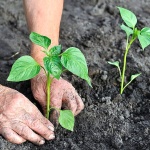
To harvest a tasty and rich harvest of pepper, you need to comply with all the conditions of agricultural technology, and proper care begins with planting plants. Before planting pepper in open ground, it should be prepared. It is also important to take care of the seedlings and planting space in advance.
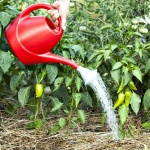
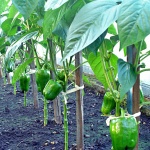
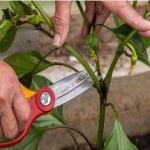
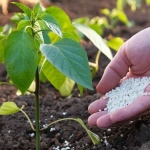
For good growth of pepper bushes and active fruiting, you need to regularly apply mineral and organic fertilizing to the soil. It is necessary not only to choose the right formulations, but also to use them at the right stage in the development of culture. The frequency of top dressing is always individual. It depends directly on the composition of the land on your site. The poorer the soil composition, the more often you will need to feed the pepper.
Disease and pest resistance
The variety is relatively resistant to apical, dry and wet rot. The variety is quite good agricultural technology and preventive treatments. Before planting, the seeds are kept in a weak solution of potassium permanganate, washed, dried, and only then sown. If a tobacco mosaic virus has been noticed on the site before, the pepper seeds are best kept in a 2% caustic soda solution.
Before planting seedlings, the soil is shed with Fitosporin-M. This drug can be used several times per season.
During the growing season, regular check-ups are best. Barely begun diseases can be easily cured, for example, with a decoction of wormwood. Solution options.
2 kg of wormwood are poured with a bucket of water, boiled for 15 minutes.
A glass of chopped wormwood and a glass of sifted ash are poured with a bucket of hot water, insisted for 2 hours, filtered.
Adequate air humidity acts as a preventive measure against spider mites. It is useful to periodically spray seedlings and young peppers with a solution of "Epin" or "Zircon". In case of a serious lesion, Fitoverm is used.
Flowering plants can be affected by verticillosis, the easiest way to prevent it is by carefully monitoring watering. The soil should always be 80% moist.
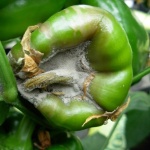
Pepper is one of the most common vegetables in home gardens. This culture is quite stable and unpretentious. However, under certain conditions, this plant can suffer from infections and harmful insects. Before treating peppers for diseases or pests, you need to find out the cause of the problem, otherwise the treatment may be ineffective.
Review overview
The reviews are positive, no exceptions. The variety is liked by Russian gardeners. The peppers are juicy and delicate in taste, with impressive thick walls. The plant is unpretentious, willingly accepts different growing schemes, surprisingly feels great even in cold regions of the Russian Federation, where peppers are difficult to grow. Belozerka pepper should be considered by anyone looking for a tasty, productive, hardy and showy variety.
